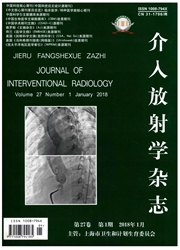

 中文摘要:
中文摘要:
目的探讨不同浓度对比剂对脑血管3D-DSA成像效果的影响及应用价值。方法前瞻性收集疑似颅内动脉瘤患者并依据对比剂应用浓度及注射速率随机分为5组:A组350mgI/ml,3ml/s;B组350mgI/ml,4ml/s;C组400mgI/mal,3ml/s;D组400mgI/ml,4ml/s;E组270mgI/ml,4ml/s。计算轴位图像上颈内动脉岩段(C2)、眼段(C6)、大脑中动脉水平段(M1)、大脑前动脉水平段(A1)信噪比(SNR)、对比噪声比(CNR),对容积再现(VR)及最大密度投影(MIP)重建图像进行评分,记录患者所用对比剂总量及术前、术后24h、术后48h血清肌酐(SCr)值。结果比较不同浓度相同注射速率对比剂应用结果,A、C两组间C2、C6、M1、A1段SNR、CNR值差异均有统计学意义(P〈0.05);B、D两组,B、E两组及D、E两组间C2段SNR、CNR值差异均有统计学意义(P〈0.05),C6、M1、A1段SNR、CNR值差异均无统计学意义(P〉0.05);A、B两组,C、D两组间C2、C6、M1、A1段SNR、CNR差异均无统计学意义(P〉0.05)。5组间VR、MIP图像主观评分差异均无统计学意义(P〉0.05)。采用3种不同浓度对比剂患者间对比剂注射总量及术前、术后24h、48hScr升高值差异均无统计学意义(P〉0.05)。结论脑血管3D—DSA检查中,较高浓度对比剂可用于无肾功能异常患者,但肾功能异常患者应慎用。3种浓度对比剂对患者48h内SCr值的影响无差异。
 英文摘要:
英文摘要:
Objective To investigate the influence of different concentration contrast media on cerebral three-dimensional digital subtraction angiography (3D-DSA) imaging quality, and to discuss its clinical application value. Methods A total of 95 patients with suspected intracranial aneurysm were prospectively collected. According to the used concentration and injection rate of the contrast medium the patients were randomly divided into five groups: group A (350 mgI/ml, 3 ml/s), group B (350 mgI/ml, 4 ml/s), group C (400 mgI/ml, 3 ml/s), group D (400 mgI/ml, 4 ml/s) and group E (270 mgI/ml, 4 ml/s). Both the signal-to-noise ratio (SNR) and contrast-to-noise ratio (CNR) of the C2 and C6 segment of internal carotid artery, the M1 segment of middle cerebral artery and the A1 segment of anterior cerebral artery were calculated on the axial images. The reconstructed images with volume rendering (VR) and maximum intensity projection (MIP) technique were separately evaluated by two physicians. The total used dose of contrast medium was recorded, the serum creatinine levels were determined before the treatment as well as 24 h and 48 h after the treatment. Results When different concentrations and the same injection rate were used, statistically significant differences in SNR and in CNR of C2, C6, M1 and A1 existed between group A and group C (all P〈0.05) ; statistically significant differences in SNR and in CNR of C2 existed between group B and group D, between group B and group E as well as between group D and group E (all P〈0.05), while no statistically significant differences in SNR and in CNR of C6, Nil and A1 were found between group B and group D, between group B and group E as well as between group D and group E (all P〉0.05); The differences in SNR and in CNR of C2, C6, M1 and A1 between group A and group B as well as between group C and group D were not statistically significant (all P〉0.05). The differences in subjective scoring of VR and MIP images were n
 同期刊论文项目
同期刊论文项目
 同项目期刊论文
同项目期刊论文
 期刊信息
期刊信息
